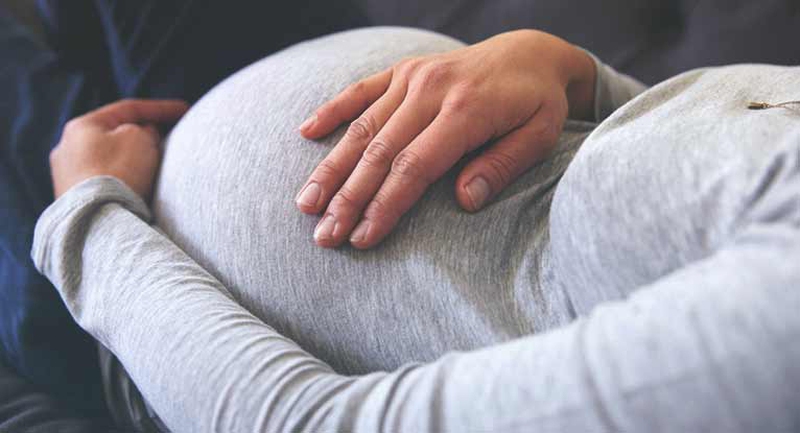All pregnant women should be more aware of their body when they are pregnant, because even the most minor changes in the body can lead to more severe health issues that are better looked at sooner rather than later. A common concern for many pregnant women is a brownish discharge. While most often, this is not an issue; in other cases, this can be a dangerous health problem for mom and baby.

What Causes Brownish Discharge During Pregnancy?
Fertilization of the Egg
Is this a serious issue? No.
After the egg has been fertilized by the sperm, the egg makes its way to the uterus as an embryo. When the embryo attaches itself to the lining of the uterus, some bleeding may occur. This tends to occur about two weeks after conception. This brown discharge, spotting or bleeding will typically occur around the same time as you regular period would have started. This amount of bleeding can vary from a small amount to a more significant amount. Most often this is not a cause for concern and will require no additional treatment.
During Intercourse
Is this a serious issue? No.
Because the cervix is more sensitive during pregnancy, sexual intercourse can cause irritation to the cervix more easily. Regular sexual activity can cause a slight pain and even result in a brownish discharge to occur.
Miscarriage
Is this a serious issue? No.
When there is damage to the fetus, the woman may experience a spontaneous miscarriage. This loss of the fetus will typically cause bleeding that can result in a brownish discharge during pregnancy or bright red discharge. This can be a significant amount of bleeding or may just be a little bit of spotting. These spontaneous miscarriages can result in a complete or incomplete discharge of the fetus. The fetus will be completely discharged from the body or it can remain lodged in the body. In cases where the fetus has not been completely discharged, a doctor will need to use a form of uterine evacuation.
Abortions
Is this a serious issue? No.
Missed abortions result when the fetus is unable to develop fully or dies while in the uterus. A brownish discharge can occur accompanied by other symptoms like pain or a clot discharge. Missed abortions will often be treated by a doctor with a form of uterine evacuation.
Ectopic Pregnancies
Is this a serious issue? Yes.
Some women will experience a pregnancy where the embryo will attach itself to the fallopian tubes instead of the uterus. When this occurs, a brownish discharge or spotting and bleeding may occur. This discharge will also be accompanied by additional symptoms, such as cramps, severe abdomen pain as well as dizziness or fainting. These types of pregnancies can be serious and even life-threatening for the mother. Most doctors will immediately terminate the pregnancy when they have an ectopic pregnancy.
GTD (Gestational Trophoblastic Disease)
Is this a serious issue? Yes.
More commonly known as molar pregnancies, Gestational trophoblastic diseases is not the result of a pregnancy at all. Instead, an abnormal growth that resembles a fetus is occurring inside the uterus. These growths can be cancerous and will need immediate medical attention because it can spread quickly throughout the body. There are various treatments for different types of molar pregnancies. Your doctor will decide the best one for your condition.
Placental Abnormalities
Is this a serious issue? Yes.
Placenta previa and placental abruption are two abnormalities that can occur in the placenta that can result in a brownish discharge during pregnancy. When placenta previa occurs, the placenta ends up covering the opening of the cervix. When this occurs, there is typically no pain along with the brownish discharge. A placental abruption will occur when the placenta becomes separated from the uterus. When this separation occurs, there will be pain in the abdomen with the discharge. Immediate medical attention is need for both of these abnormalities because they can cause additional health issues for the unborn child.
Before Labor
Most women will experience bleeding when they are about to go into labor. This is often caused by the detachment of the mucous plug. This can also be a signal of preterm labor if the pregnancy is before the 37th week. This discharge can occur days and even weeks prior to labor. Pains in the lower back, cramps, and uterine contractions can all occur along with the brownish discharge.
Additional Causes
There are many other conditions that can cause brownish or red discharge during pregnancy.
Vaginitis and cervicitis. These types of sexually transmitted diseases cause inflammation in the vagina or to the cervix.
Trauma to the vagina or cervix.
Cancer in the reproductive organs.
Cervical polyp. This is the result of a tumor growing on the surface of the cervical canal.
When Should You See a Doctor?
During your pregnancy, you should keep a close eye on any symptoms you have. While a brownish discharge during pregnancy is generally normal when accompanied with no other signs or symptoms, this can also be a cause for concern when accompanied with other symptoms. The following is a list of symptoms you'll want to consult your doctor about immediately.
If the discharge has turned colors to either a light or darker red.
If the discharge turns gray in color.
If there is pain or tenderness around the vagina or abdomen.
If contraction begins in the lower back or uterus.
View All Comments /Add Comment